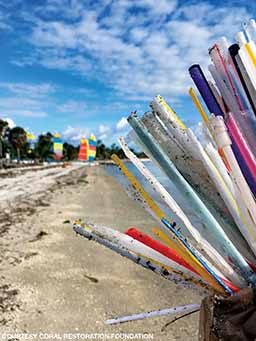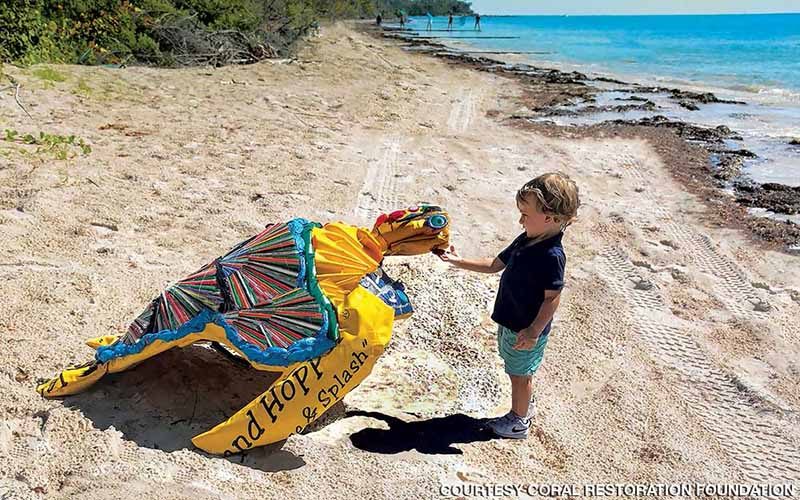The project started when about 20 people on the Coral Restoration Foundation team met for drinks in the Florida Keys. As a new intern I was excited to be surrounded by so many fellow divers and ocean advocates. My mood swiftly changed, however, when our 20 waters and 20 cocktails came out in plastic cups, each one containing a plastic straw. I could see the discomfort in everyone’s faces as we stared at our cluttered table; this mountain of plastic would either sit in a landfill for thousands of years or be blown into the ocean before then. I impulsively collected the straws; later that evening I began sketching ideas for a sculpture made of plastic marine debris.
Americans use 500 million straws every day, according to the National Park Service. On average, straws are used for only a few minutes, yet they last essentially forever and contribute to the 14 billion tons of plastic trash entering our oceans each year. The Ocean Conservancy determined that straws are consistently among the top 10 items found during coastal cleanups both nationally and internationally and are one of the most harmful items to marine wildlife, which may accidentally ingest or become entangled in them.
Since plastics are not biodegradable, they break down into smaller and smaller pieces, eventually becoming microplastics at 5 millimeters or smaller; unfortunately, they never fully disappear. Furthermore, as pieces of plastic become smaller, they become ingestible by more and more marine organisms, including juvenile turtles and even corals. Plastics can also make their way up the food chain as larger animals eat smaller fish that have ingested plastics.
Join the Movement
Take the straw-free pledge, and learn more about what you can do to reduce the amount of plastic straw debris at strawfree.org.
As I prepared my sculpture, I spoke with local experts about the wide-ranging effects of microplastics on wildlife. “Staff in our sea turtle hospital have found plastics in nearly 100 percent of all post-hatchling sea turtles necropsied at the Center,” said Tommy Cutt, chief conservation officer at Loggerhead Marinelife Center in Juno Beach, Florida.
“We treat a lot of sea turtles impacted by ingesting the microplastics that have accumulated in the sargassum seagrasses, where the juvenile turtles spend most of their early years,” observed Megan Mertsock, education specialist at the Turtle Hospital in Marathon, Florida. “Sea turtle experts estimate 100 million marine animals are killed each year from plastic debris in the ocean.”

Fortunately, there are alternatives. Thanks to a reusable utensil and straw set that I bought online for $12 and carry on me at all times, I have successfully quit single-use plastics for an entire year. Every person can make a difference, and it is quite easy to make the switch.
My sculpture design is based on a turtle named Hubie who we often see during our coral restoration dives. For her head and flippers I used yellow material cut out of a water trampoline we found in nearby mangroves, and I made her eyes from shampoo bottle spouts and plastic cutlery. I reserved the straws for the scutes of her carapace, assembling them to capture the starburst pattern characteristic of green sea turtles.
The process of making the sculpture was enlightening. As one of my fellow volunteers, Barbara Overtone, observed, “Sadly, it was all too easy to find discarded straws for this project.” Last year volunteers collected 32,056 plastic straws and stirrers in Florida on just one day. That’s a lot of straws, but it’s also a lot of people who care. I hope this sculpture will encourage people to quit single-use plastics and demand more ocean-friendly alternatives from local businesses.

Explore More
| © Alert Diver — Q3 2018 |